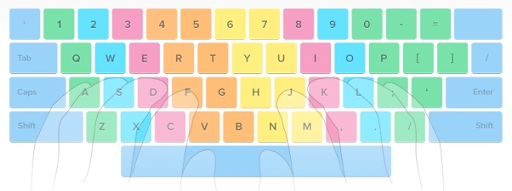Faster, better, healthier – how to type the “right” way
 Photo Credit: unsplash.com
Photo Credit: unsplash.com
The smartphones in our pockets today are exponentially more powerful than the NASA computers used during moon landings. We’re able to send messages and videos in seconds to someone on the other side of the world. The dangers posed by artificial intelligence to humanity are now the subject of serious discussions by eminent experts instead of merely the stuff of science fiction.
And yet for all the incredible leaps that technology has made, one thing has remained constant for decades. We’re talking about the trusty QWERTY keyboard. After all, it’s there on your grandparent’s typewriter, a reminder that the QWERTY is older than computers. It’s inbuilt on modern-day laptops. It’s even transcended its physical form and now lives on touch screens.
So ingrained are keyboards in our lives that typing is like tying your shoelaces – a fundamental life skill you don’t think about. And the ubiquity of the QWERTY means that it’s assumed you’ll naturally pick up how to use it through repeated exposure.
Indeed, older millennials might remember taking typing lessons eons ago, but people in their early 30s and below won’t remember learning how to type the same way we don’t remember how we learnt to speak our first language.
Still, there is truly a “correct” way to type that all of us can benefit from even if we, well, already know how to type. You might have naturally picked up how to swim after hours of messing about in the pool, but you’ll be a much better swimmer if you learn the proper techniques for executing the breaststroke. So stick around as we’ll be sharing how to maximise your typing efficiency while reaping some health benefits to boot. But before we get into that, here’s a quick historical look back at how the QWERTY keyboard came about.
How QWERTY reached the majority
The QWERTY keyboard layout – so named because of the first six letters at the top left corner – was first introduced in the second half of the 19th century in a mechanical typewriter.
Why not place the keys simply in alphabetical order? Well, mechanical typewriters were prone to jamming if keys were hit at the same time so the keyboard was a balance between enabling fast typing and jam prevention. Another explanation goes that the keyboard layout was designed for the convenience of telegraph operators transcribing Morse code, who needed certain letters close together.
What is not in dispute is the Remington typewriter winning the fight for dominance in the 1880s, then merging with four major rivals in 1893 and pushing a so-called “universal layout”: QWERTY. Remington even shrewdly offered typing courses using the QWERTY keyboard to build up a critical mass of people who preferred the layout.
Other layouts such as the DVORAK and COLEMAK keyboards have come along, but have not come close to shaking QWERTY from its perch. Sure, devotees of DVORAK tout the superior typing speed – Barbara Blackburn became a Guinness World Record holder by maintaining 150 words per minute for 50 minutes with a peak speed of 212 words per minute and she did it on a DVORAK. But how many of us need to type 150 words per minute, let alone 212?
In the end, familiarity still triumphs.
Health is wealth – why good typing habits matter
Having an impressive typing speed is what comes to mind first when mentioning good typing habits, but we believe the health aspects are much more important. We’ve all experienced soreness in our arms, neck, and back after spending too much time in front of the computer, so it might be easy to dismiss it as a temporary inconvenience. However, these aches and pains can accumulate and lead to much more serious and long-term issues.
For instance, repetitive strain injuries are caused by repeated use of certain body parts in activities such as typing. Your shoulders, elbows, forearms, wrists, hands, and fingers may experience burning, aching, or throbbing pain; stiffness and weakness; tingling, pins and needles, or numbness; cramps; and swelling. Severe cases may need to be treated by physiotherapy, steroid injections, and even surgery.
Another condition that can be caused by prolonged typing is carpal tunnel syndrome. The carpal tunnel is a passageway near your wrist for nerves and tendons. Swelling of the tunnel may press on nerves, causing pain, tingling numbness, and weakness. Serious cases can lead to persistent and even permanent numbness and weakness. And typing habits go beyond arm and hand positions, encompassing overall body posture. Poor posture while sitting can lead to discs between each vertebra of the spine to slip from their usual position and pressing on the nerve root in the spine. Such herniated discs can cause severe numbness and pain. For example, herniated discs in the lower back can cause pain to shoot down all the way to the calves.
How to adopt good typing habits
Prevention is better than cure, so even if you’re ache-free at the moment, it makes sense to start using better typing techniques now. The gold standard for typing is touch typing, which as its name suggests, means you type without looking at the keyboard. Take a closer look (and feel) of the F and J keys. Notice little raised notches? Those are for your index fingers to locate the keys by touch. The rest of your fingers on your left-hand rest on the A, S, and D keys while the rest of your fingers on your right rest on the K, L, and ; keys. The thumbs are on the keyboard. Your fingers are now in what’s known as the home row position.
 Photo Credit: wokesalaryman
Photo Credit: wokesalaryman
Each finger is in charge of a section of keys (grouped by colour) as depicted in this picture. As you can see, the index, middle, and ring fingers move up and down while the pinkies cover the outer areas.
You’ve probably developed your own quirks at the keyboard, so this is going to take some uncomfortable unlearning and relearning. You’ll see your typing speed drop and you’ll have to stick with it for some time before you see an improvement.
The ring fingers and pinkies are probably going to have the toughest going as most of us underuse them while typing. But it’s not just your fingers and your keyboard. The entire body position and workstation matter too.
Some tips include:
- with your head, neck, and back straight, not with your head craning forward.
- Have your elbows at your side and bent at 90 degrees or more.
- Wrists flat at the keyboard, not angled up or scrunched together (which can lead to nerve pain at the joints).
- Knees level with the hips or slightly below.
- Feet flat on the ground.
These best practices ensure that you’re not only optimising your typing speed but also keeping aches and pains away. Of course, get up and move about after a period of continuous sitting. Too much time typing away is stressful, no matter how ergonomic your workstation is.
QWERTY can be speedy and healthy
Did you know that besides the QWERTY layout, you can choose the AZERTY, QWERTZ, and yes, the Dvorak layouts on an iPhone? This may seem cool, but chances are, we’re going to stick with what we know – the good ol’ QWERTY keyboard.
But staying with the familiar is no excuse for not pushing for improvements. You’re going to hit seriously impressive speeds on the keyboard and you’ll reap the benefits, be it at work or having a cool party trick up your sleeves. And your spine, wrists, and the rest of your body will thank you down the road when they’re spared the aches that afflict so many office workers.
Returning to the swimming metaphor, learning the proper way to execute the breaststroke will make you feel like you’ve never known how to swim, but it’ll all be worth it when you’re flying through the water.
https://www.tech.gov.sg/media/technews/how-to-type-the-right-way
